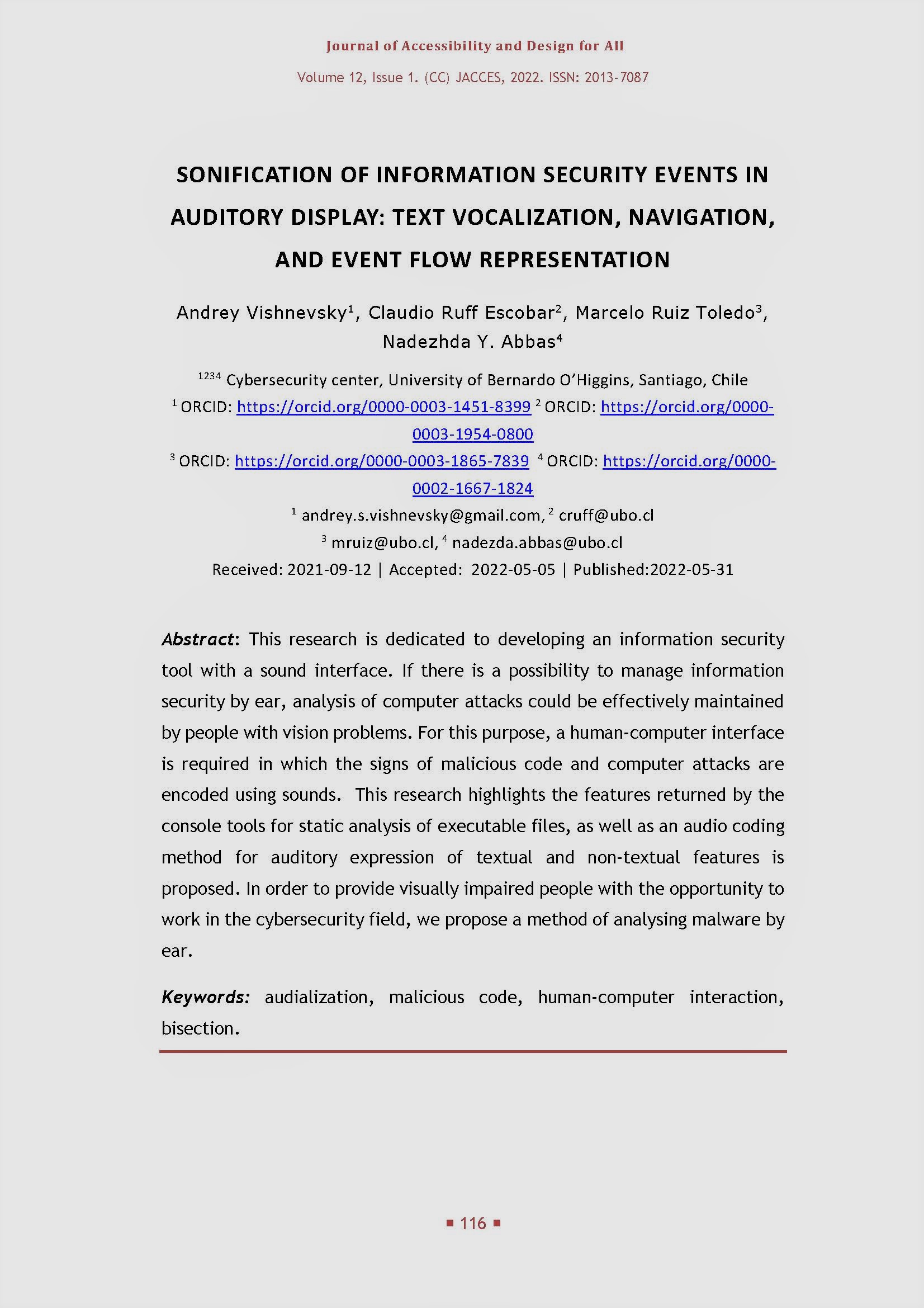Sonification of information security events in auditory display
DOI:
https://doi.org/10.17411/jacces.v12i1.359Abstract
This research is dedicated to developing an information security tool with a sound interface. If there is a possibility to manage information security by ear, analysis of computer attacks could be effectively maintained by people with vision problems. For this purpose, a human-computer interface is required in which the signs of malicious code and computer attacks are encoded using sounds. This research highlights the features returned by the console tools for static analysis of executable files, as well as an audio coding method for auditory expression of textual and non-textual features is proposed. In order to provide visually impaired people with the opportunity to work in the cybersecurity field, we propose a method of analysing malware by ear.References
Fourie L., Pang S., Kingston T., Hettema H., Watters P., Sarrafzadeh H. (2014). The global cyber security workforce – an ongoing human capital crisis. Paper presented at the 2014 Global Business and Technology Association Conference (pp. 173-184). Baku, Azerbaijan: Global Business and Technology Association.
Mikhail M.B., Walther B.R., Willis R.H. (2003). The effect of experience on security analyst underreaction. 35(1), 101-116. Journal of Accounting and Economics. https://doi.org/ 10.1016/S0165-4101(02)00099-X
McDonnall M.C., Crudden A. (2015). Building Relationships with Businesses: Recommendations from Employers concerning Persons Who Are Blind/visually impaired. 81(3), 43-70. Journal of Rehabilitation.
World Health Organization. (2012). WHO releases new global estimates on visual impairment. Retrieved from http://www.emro.who.int/control-and-preventions-of-blindness-and-deafness/announcements/global-estimates-on-visual-impairment.html (accessed: 10.04.2022)
Vision Loss Expert Group of the Global Burden of Disease Study. Causes of blindness and vision impairment in 2020 and trends over 30 years: evaluating the prevalence of avoidable blindness in relation to “VISION 2020: the Right to Sight”. Lancet Global Health 2020.. . https://doi.org/10.1016/S2214-109X(20)30489-7
Dorigo M.L., Harriehausen-Mühlbauer B., Stengel I., Haskell-Dowland P.S. (2013). Nonvisual Presentation and Navigation within the Structure of Digital Text-Documents on Mobile Devices. Paper presented at the Universal Access in Human-Computer Interaction. Applications and Services for Quality of Life (pp. 311-320). Berlin, Heidelberg: Springer. . https://doi.org/10.1007/978-3-642-39194-1_37
Keller P, Stevens C. (2004). Meaning from environmental sounds: types of signal-referent relations and their effect on recognizing auditory icons. 10(1), 3-12. Journal of Experimental Psychology: Applied. https://doi.org/10.1037/1076-898X.10.1.3
Frauenberger C., Noisternig M. (2003). 3D Audio Interfaces for the Blind. Paper presented at the 2003 International Conference on Auditory Display (pp. 280-283). Boston, MA, USA: Boston University Publications.
Hermann T, Hunt A, Neuhoff J.G (2011). The sonification hand-book. Berlin, Germany: Logos. isbn: 978-3-8325-2819-5
Kuznecov L.A. Akustika muzykal’nyh instrumentov (1989). Spravochnik. Moskva, RSFSR: Legprombytizdat. isbn: 5-7088-0166-2
Bożena K. (2005). Perception-Based Data Processing in Acoustics. Applications to Music Information Retrieval and Psychophysiology. Berlin, Heidelberg: Springer. isbn: 978-3-540-25729-5
Noll T., Clampitt D. Exploring the Syntonic Side of Major-Minor Tonality (2019). Paper presented at the Mathematics and Computation in Music (pp. 125-136). Cham, Switzerland: Springer. https://doi.org/10.1007/978-3-030-21392-3_10
Berry C., Fiore T. (2016). Hexatonic Systems and Dual Groups in Mathematical Music Theory. 11(2), 253-270. Involve: a Journal of Mathematics. https://doi.org/10.2140/involve.2018.11.253
Hughes J.R. Using Fundamental Groups and Groupoids of Chord Spaces to Model Voice Leading (2015). Paper presented at the Mathematics and Computation in Music (pp. 267-278). Cham, Switzerland: Springer. https://doi.org/10.1007/978-3-319-20603-5_28
Peck R.W. All-Interval Structures (2015). Paper presented at the Mathematics and Computation in Music (pp. 279-290). Cham, Switzerland: Springer. https://doi.org/10.1007/978-3-319-20603-5_29
Christiane N. (2017). Methods in Neuromusicology: Principles, Trends, Examples and the Pros and Cons (Schneider A., Ed.) Studies in Musical Acoustics and Psychoacoustics (341-374). Cham, Switzerland: Springer International Publishing. https://doi.org/10.1007/978-3-319-47292-8
Falk, C. (2019) The 25th International Conference on Auditory Display (ICAD 2019). Sonification with music for cybersecurity situational awareness (50-55). Northumbria University, Newcastle upon Tyne, UK. https://doi.org/10.21785/icad2019.014
Su I. (2021) Interactive exploration of a hierarchical spider web structure with sound. Journal on Multimodal User Interfaces. https://doi.org/10.1007/s12193-021-00375-x
Cai Y. (2021) Compositional Sonification of Cybersecurity Data in a Baroque Style. In: Ahram T.Z., Karwowski W., Kalra J. (eds) Advances in Artificial Intelligence, Software and Systems Engineering. AHFE 2021. Lecture Notes in Networks and Systems, vol 271. Springer, Cham. https://doi.org/10.1007/978-3-030-80624-8_38
Web Speech API https://developer.mozilla.org/en-US/docs/Web/API/Web_Speech_API (accessed: 10.04.2022)
BASS Audio Library https://www.un4seen.com/ (accessed: 08.08.2021)
Vishnevsky A. (2022). Sonification of Information Security Incidents In An Organization Using A Multistep Cooperative Game Model. In: A. Rocha et al. (Eds.) WorldCIST: World Conference on Information Systems and Technologies 2022. Lecture Notes in Networks and Systems, vol 468, pp. 1–9. Springer Nature Switzerland AG 2022. https://doi.org/10.1007/978-3-031-04826-5_30

Downloads
Published
How to Cite
Issue
Section
License
Copyright (c) 2022 Andrey Vishnevsky, Claudio Ruff Escobar, Marcelo Ruiz Toledo, Nadezhda Y. Abbas

This work is licensed under a Creative Commons Attribution-NonCommercial 4.0 International License.
- Authors retain copyright and grant the journal right of first publication with the work simultaneously licensed under a Creative Commons Attribution License that allows others to share or adapt the work with an acknowledgment of the work's authorship and initial publication in this journal. Use of the work for commercial purposes are not allowed.
- Authors are able to publish the journal's published version of the work in other media (e.g., post it to an institutional repository or publish it in a book), as far as they inform the Journal of Accessibility and Design for All of that fact. When publishing their work in other sources, authors must mention the name of the Journal of Accessibility and Design for All, its ISSN, the number and issue in which the article was published and a link to the main page of the Journal of Accessibility and Design for All. Optionally, they can also include a link to the article published in the Journal of Accessibility and Design for All.
- Authors are permitted and encouraged to post their work online (e.g., in institutional repositories or on their website), as it can lead to productive exchanges, as well as earlier and greater citation of published work.



